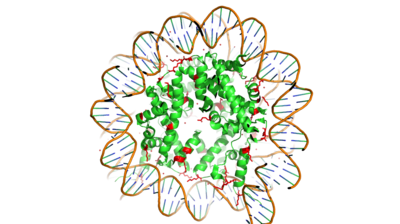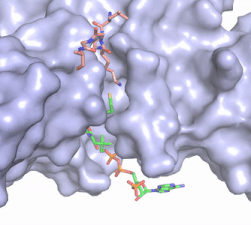User:Caitlin Marie Gaich/Sandbox1
From Proteopedia
(Difference between revisions)
| Line 19: | Line 19: | ||
Once the complex has formed, histone 4 and AcetylCoA can begin to interact. The N-terminal segment of H4 that binds with HAT1/HAT2 can be divided into <scene name='81/811717/Ntail_regions/3'>three different regions</scene>. Similar to 1BOB the N-terminal region of H4 is embedded in a cave between HAT1 and HAT2, though H4 mainly interacts with HAT1. The C-terminal helix of H4 is found inserted into LP2, the N-terminal helix, and C-terminal groove of HAT2. These interactions are strongly stabilized by salt bridge bonds between the histone and the complex. Previous studies suggest that H4K12 inserts into the active site of HAT1 to access AcCoA.<ref name="Wu">PMID:22615379</ref> The 4PSW structure has H4K12 aligned with the active site and the AcCoA entering the concave groove from the opposite side. This allows the ε-amino group of H4K12 to contact the SH group of CoA. | Once the complex has formed, histone 4 and AcetylCoA can begin to interact. The N-terminal segment of H4 that binds with HAT1/HAT2 can be divided into <scene name='81/811717/Ntail_regions/3'>three different regions</scene>. Similar to 1BOB the N-terminal region of H4 is embedded in a cave between HAT1 and HAT2, though H4 mainly interacts with HAT1. The C-terminal helix of H4 is found inserted into LP2, the N-terminal helix, and C-terminal groove of HAT2. These interactions are strongly stabilized by salt bridge bonds between the histone and the complex. Previous studies suggest that H4K12 inserts into the active site of HAT1 to access AcCoA.<ref name="Wu">PMID:22615379</ref> The 4PSW structure has H4K12 aligned with the active site and the AcCoA entering the concave groove from the opposite side. This allows the ε-amino group of H4K12 to contact the SH group of CoA. | ||
| - | ===Acetyl-CoA Binding Site=== | + | ===Acetyl-CoA (CoFactor) Binding Site=== |
[[Image:Hat1.gif|400 px|left|thumb|Figure 2. Acetyl-CoA in the binding pocket of HAT1 (Chain A)]] | [[Image:Hat1.gif|400 px|left|thumb|Figure 2. Acetyl-CoA in the binding pocket of HAT1 (Chain A)]] | ||
The acetyl-CoA HAT1 active site is parallel to the C-terminal domain of the HAT1 protein. Acetyl-CoA fits structurally into the small binding site due to the kinked pantetheine group giving the molecule a bent confirmation. Once bound, most of the acetyl-CoA molecule is buried in the protein, around 60% (Figure 3). Hydrophobic contacts, hydrogen bonds, and salt bridges help to stabilize the protein-ligand interaction. HAT1 protein-ligand contact is concentrated in three areas: C-terminal end of helix α 7, C terminal end of strand β-14/loop β15-α9, and N-terminal half of helix α 9 <ref name=”Dutnall”>PMID:10384314</ref>. | The acetyl-CoA HAT1 active site is parallel to the C-terminal domain of the HAT1 protein. Acetyl-CoA fits structurally into the small binding site due to the kinked pantetheine group giving the molecule a bent confirmation. Once bound, most of the acetyl-CoA molecule is buried in the protein, around 60% (Figure 3). Hydrophobic contacts, hydrogen bonds, and salt bridges help to stabilize the protein-ligand interaction. HAT1 protein-ligand contact is concentrated in three areas: C-terminal end of helix α 7, C terminal end of strand β-14/loop β15-α9, and N-terminal half of helix α 9 <ref name=”Dutnall”>PMID:10384314</ref>. | ||
| - | The β-methyl of the acetyl group interactions in the hydrophobic pocket formed by the side chain of residues: <scene name='81/811717/Hydrophobic_pocket/4'>Ile-217,Pro-257, Phe-261</scene>. The carbonyl oxygen of the acetyl group <scene name='81/811717/Phe_interaction/3'>hydrogen bonds with the amide</scene> of the main chain Phe-220 and the sulfur of the acetyl-group <scene name='81/811717/Asn_ligand_interaction/1'>interacts, as a hydrogen bond,</scene> with Asn-258. These interactions keep acetyl-CoA in the correct position of the active site for the transfer of the acetyl-group. | + | The β-methyl of the acetyl group interactions in the hydrophobic pocket formed by the side chain of residues: <scene name='81/811717/Hydrophobic_pocket/4'>Ile-217,Pro-257, Phe-261</scene>. The carbonyl oxygen of the acetyl group <scene name='81/811717/Phe_interaction/3'>hydrogen bonds with the amide</scene> of the main chain Phe-220 and the sulfur of the acetyl-group <scene name='81/811717/Asn_ligand_interaction/1'>interacts, as a hydrogen bond,</scene> with Asn-258. These interactions keep acetyl-CoA in the correct position of the cofactor active site for the transfer of the acetyl-group. |
= Mechanism = | = Mechanism = | ||
Revision as of 00:16, 26 April 2019
Histone Acetyltransferase HAT1/HAT2 Complex, Saccharomyces cerevisiae
| |||||||||||



